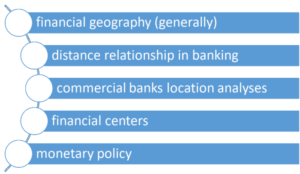The literature about financial geography is largely defined by three parts: financial geography (general), distance relations in banking, and location analysis of commercial banks. Two important parts of financial geography are, however, rarely discussed in their relationship to each other: financial centers and monetary policy. This paper is devoted to an analysis of the literature and important points on the relationship between monetary policy and regional science. This literature review shows the importance of monetary theory for regional development, and the importance of spatial effects on monetary policy. The working paper focuses on these two issues, which are usually are ignored in empirical analyses. The interest rate channel hypothesis assumes an increase in the cost of borrowing. The equity channel of monetary policy works through a wealth effect triggered by decreased interest rates. As the literature suggests, we should search for other reasons for these types of asymmetries. An interesting conclusion from reviewing all these studies is that a different industry mix across regions is the only convincing explanation for regional asymmetric responses to monetary policy shocks. In contrast, a traditional effect through a credit channel, possibly operated at the national level, is not reflected in the regional asymmetries.

Source: FinGeo WP33. Avetisyan, S. (2021) The Local Effects of Monetary Policy
